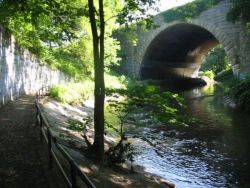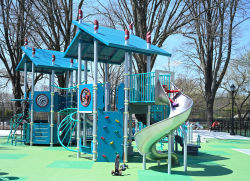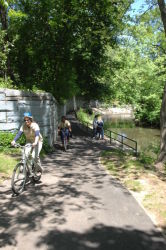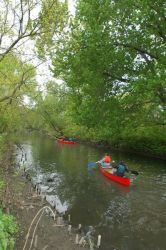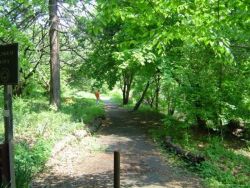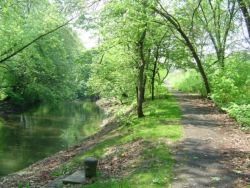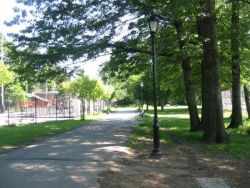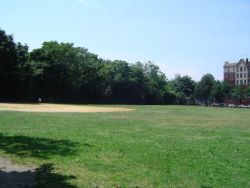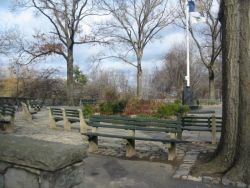Bronx Park
Cunnion-Hourigan-McCarthy-Gall Fields
What was here before?
These ballfields are part of Bronx Park, named for sea captain Jonas Bronck (1600-1643) who settled the area. He built a stone home in what is now Morrisania, which notably hosted a peace conference with the Weckquaesgeek in 1642. Bronck’s property was broken up and passed through several families. In 1914, the City of New York constructed Allerton Avenue on what was previously the Hammersley family estate, a property mapped in 1856. Allerton Avenue between Lurting and Tenbroeck Avenues was originally known as Thomas Haddon’s Saw Mill Lane after a 1720 mill used to cut trees into lumber. The stretch of Allerton Avenue between Bronx Park and Cruger Avenue was previously known as Bleecker Street.
How did this site become a ballfield?
Between December 1888 and January 1889, the City of New York acquired 640 acres of land to create Bronx Park. In 1891, the City allotted 250 acres to the New York Botanical Society to create The New York Botanical Garden. It allotted another 250 acres to the New York Zoological Society in 1898 to build the Bronx Zoo, which opened the following year and lies just south of these ballfields.
At the time of their construction, these ballfields were known as Allerton Fields, honoring early Bronx settler Daniel Allerton (1818-1877), who purchased and farmed this area with his wife Hustace in the mid-19th century. Allerton was a descendent of Isaac Allerton (1586-1659), the fifth signer of the Mayflower Compact, which ensured the establishment of a civil government, the rule of law, and that governance would be carried out by mutual consent in the newly-founded colony in Plymouth, Massachusetts.
Who is this ballfield named for?
In 1968, the ballfields were renamed to honor four Bronxites killed in the Vietnam War. Michael A. Cunnion, William J. Hourigan, Jr., Peter R. McCarthy, and Robert J. Gall grew up in the Bedford Park section of the Bronx, where they all attended nearby St. Philip Neri School and played baseball at Allerton Fields as children.
Cunnion was an alumnus of Mount St. Michael High School in the Bronx, and later attended Holy Cross College on a football scholarship before joining the Marines. He was killed in action on July 15, 1966 when his helicopter was shot down in Operation Hastings.
Hourigan played baseball at Cardinal Hayes High School and studied at St. John’s University for two years before he also enlisted with the Marines. He was killed in action at Da Nang on December 11, 1966.
Like Cunnion, McCarthy attended Mount St. Michael High School, before enrolling at Bronx Community College. He served in the U.S. Army in the 7th Regiment of the 1st Air Cavalry Division and earned the Air Medal and two Purple Hearts before he was killed on April 8, 1967.
Gall was an avid baseball player and enlisted in the U.S. Marines Reserves before he was sent to Vietnam. He was killed on September 10, 1967 during Operation Kingfisher. He earned a Purple Heart for his actions in combat.
Check out your park's Vital Signs
Clean & Safe
Green & Resilient
Empowered & Engaged Users
Share your feedback or learn more about how this park is part of a
Vital Park System

